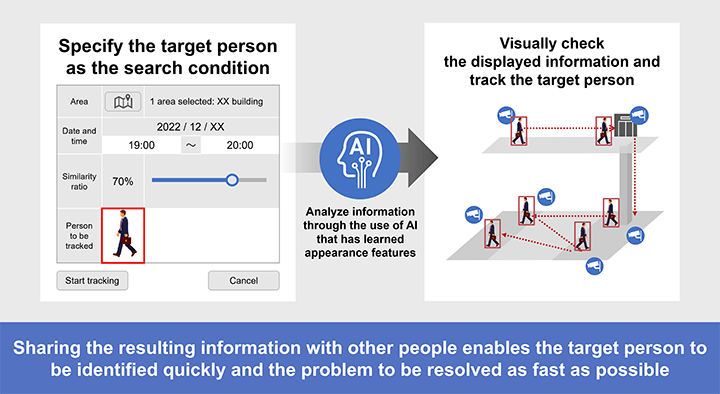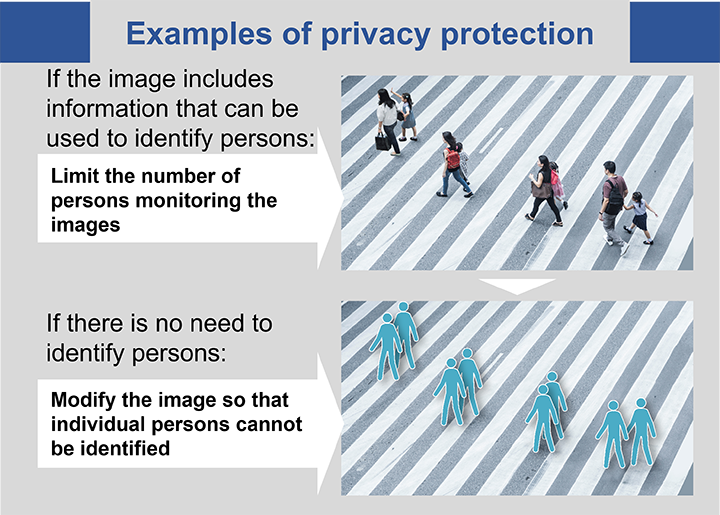Featured customer case
Lumada customer case code: UC‑01690S
The solution for fast person identification and tracking (IVSearch) leverages AI image analysis to refine monitoring operations and help improve efficiency
2023‑05‑31

You might notice that an increasing number of surveillance cameras are being installed in public places to ensure safety and peace of mind. The footage from surveillance cameras can be analyzed by AI (artificial intelligence) to identify persons of interest, such as suspicious persons or lost children, and track them. This article describes a customer case in which AI was used to extract and analyze personal features, and to narrow down target persons. The use of AI improved the accuracy and efficiency of monitoring operations.
Hitachi offers AI technology that analyzes surveillance camera footage, identifies target persons, and tracks them. This technology can also be applied to business areas other than security‑related businesses.
As an example of use, a company could analyze videos from a shopping center, identify the personal features of shoppers, and collect various types of information (for example, how the number of shoppers changes depending on the weather or seasonal events). This helps the company to examine and implement the right marketing strategies.
Lumada for co‑creation—Conduct analysis by using AI that has learned personal features
Surveillance cameras are installed in large shopping centers and event venues to ensure safety and provide peace of mind for people in those locations.
In places containing many people, many different problems (either major or minor) occur almost every day. For example, shoppers might leave their bags unattended, or children might get lost. If such a problem is reported to the security office, the information desk, or staff members, they can quickly resolve the problem by analyzing surveillance camera footage, quickly identifying the persons involved in the problem, and tracking them to their current location.
In order to solve a problem quickly, information can be collected from witnesses regarding features of the person of interest, for example, their hairstyle, the color of their clothes, and the type of their bag. Using this information as clues, the persons monitoring can check the surveillance camera footage. However, people in the video might have their back turned to the camera or might be too small to be identified, so the persons examining the footage might be unable to visually identify the person of interest.
If time has passed since the problem occurred, the person involved in the problem might have moved away from the original site. To track the target person, those monitoring must watch the surveillance camera footage from start to finish. As this footage must be examined visually, it can take the persons monitoring a considerable amount of time to identify the whereabouts of a person.
To identify a person involved in a problem as quickly as possible, you can take advantage of AI‑based image analysis using an AI that has learned physical and appearance features (for example, hairstyles, types and colors of clothes, and types of bags).
Surveillance cameras can collect images only from a limited range. Depending on the camera angle or the distance from the filmed person, the camera footage might not include parts of the human body that enable the person to be identified. Even if the persons monitoring only see people’s backs or small images of the persons in the camera footage, they will still be able to quickly narrow down the list of persons who look similar to the person with the features described by witnesses. In order to do this, you specify the physical and appearance features described by witnesses and then use an AI, which has learned the personal features, to analyze the video. The persons monitoring can identify the person just by examining a narrowed‑down group of persons, which reduces the time required for their monitoring operations.

If you specify an image of the target person as a search condition and then use AI, which has learned the personal features of the target person described by witnesses, to analyze videos from multiple cameras installed around the place where the target person was present, the AI will examine the locations of the cameras and the times when the videos were taken and then show you the route traveled by the target person. As such, the persons monitoring can visually track where and when the target person was present, without needing to watch a huge number of videos. Sharing the resulting information with other people enables the target person to be identified quickly and the problem to be resolved as fast as possible.


AI image analysis utilizes machine learning. The AI automatically recognizes features of persons and objects based on a huge amount of image data that has been learned and accumulated. Using an AI can reduce the burden on the persons monitoring by reducing their work and the labor hours required to visually check images.
The accuracy of automatic recognition can vary depending on the data that the AI has learned. You can improve the AI performance by properly performing data cleansing and adding annotations. Data cleansing is the process of removing incorrect data and other data that is irrelevant to the objects or persons that the AI is to recognize. Annotations are labels that explain the features of the objects or persons.
In addition, you must consider the privacy of the people recorded in camera footage. You need to clarify the purpose of analyzing the images and videos and take appropriate measures. For example, if the images include information that can be used to identify individual persons, you must limit the number of persons monitoring the images. If there is no need to identify individual persons, you need to implement image processing* to protect the privacy of those persons.
AI technologies are essential for improving accuracy and efficiency, and reducing the cost of monitoring operations.
The Hitachi Lumada solution called solution for fast person identification and tracking (IVSearch) is an example of such an AI technology. The article below explains this solution.